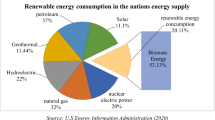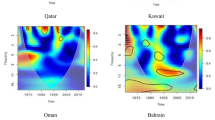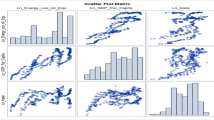Abstract
This study analyzes the causal associations between economic growth (GDP) and biomass energy consumption (BIO) in the US, UK, and BRICS countries for the period 1990 to 2020 in time–frequency space. The use of wavelets is what distinguishes our approach, i.e., cross wavelet transform, wavelet coherence, and the wavelet-based Granger causality method proposed by Olayeni (2016), which quantifies the causal associations in the time–frequency space. The results uncover that the causal relationships between GDP and BIO are not uniform across time and frequency. In fact, there is a positive relationship between GDP and BIO indicators in the BRICS countries in the medium and long term and in the USA and UK in the short term throughout the research period. In addition, a bidirectional causal effect between GDP and BIO exists in China, Brazil, and India, while there is no long-run causal relationship between GDP and BIO in India and South Africa. The causal impacts of economic growth on biomass energy usage are more pronounced in these countries than in the opposite direction, especially over longer time horizons. The key conclusion is that these countries should boost their biomass energy consumption to promote economic growth and reduce energy reliance.







Similar content being viewed by others
Availability of data and materials
Please contact author for data and program codes requests. R and Matlab are used to organize data.
References
Adebayo TS, Kirikkaleli D (2021) Impact of renewable energy consumption, globalization, and technological innovation on environmental degradation in Japan: application of wavelet tools. Environ Dev Sustain 1–26
Adebayo TS, Akinsola GD, Kirikkaleli D, Bekun FV, Umarbeyli S, Osemeahon OS (2021) Economic performance of Indonesia amidst CO 2 emissions and agriculture: a time series analysis. Environ Sci Pollut Res 1–15
Ajmi AN, Inglesi-Lotz R (2020) Biomass energy consumption and economic growth nexus in OECD countries: a panel analysis. Renew Energy 162:1649–1654
Alam MS, Shahzad SJH, Ferrer R (2019) Causal flows between oil and forex markets using high-frequency data: asymmetries from good and bad volatility. Energy Econ 84:104513
Ali HS, Law SH, Yusop Z, Chin L (2017) Dynamic implication of biomass energy consumption on economic growth in Sub-Saharan Africa: evidence from panel data analysis. GeoJournal 82(3):493–502
Ali HS, Adaa AHMA, Lin WL, Youssouf MA (2018) Biomass energy consumption and economic growth: panel data evidence from ASEAN member countries. GeoJournal 83(6):1339–1348
Aslan A (2016) The causal relationship between biomass energy use and economic growth in the United States. Renew Sustain Energy Rev 57:362–366. Energy 179:272–283
Assaf A, Bilgin MH, Demir E (2021) Using transfer entropy to measure information flows between cryptocurrencies. Phys A: Stat Mech Appl 126484
Aydin M (2019) The effect of biomass energy consumption on economic growth in BRICS countries: a country-specific panel data analysis. Renew Energy 138:620–627
Bildirici ME (2012) The relationship between economic growth and biomass energy consumption. J Renew Sustain Energy 4(2):023113
Bildirici ME (2013) Economic growth and biomass energy. Biomass Bioenerg 50:19–24
Bildirici ME (2014) Relationship between biomass energy and economic growth in transition countries: panel ARDL approach. Gcb Bioenergy 6(6):717–726
Bildirici ME (2016) Biomass energy consumption and economic growth: ARDL analysis. Energy Sources Part B 11(6):562–568
Bildirici M, Ozaksoy F (2017) The relationship between woody biomass consumption and economic growth: nonlinear ARDL and causality. J For Econ 27:60–69
Bildirici M, Özaksoy F (2018) An analysis of biomass consumption and economic growth in transition countries. Econ Res-Ekon Istraž 31(1):386–405
Bilgili F, Ozturk I (2015) Biomass energy and economic growth nexus in G7 countries: evidence from dynamic panel data. Renew Sustain Energy Rev 49:132–138
Chien F, Ajaz T, Andlib Z, Chau KY, Ahmad P, Sharif A (2021) The role of technology innovation, renewable energy and globalization in reducing environmental degradation in Pakistan: a step towards sustainable environment. Renew Energy 177:308–317
Destek MA (2017) Biomass energy consumption and economic growth: evidence from top 10 biomass consumer countries. Energy Sources Part B 12(10):853–858
Gao J, Zhang L (2021) Does biomass energy consumption mitigate CO2 emissions? The role of economic growth and urbanization: evidence from developing Asia. J Asia Pac Econ 26(1):96–115
Godil DI, Yu Z, Sharif A, Usman R, Khan SAR (2021) Investigate the role of technology innovation and renewable energy in reducing transport sector CO2 emission in China: a path toward sustainable development. Sustain Dev 29(4):694–707
He X, Mishra S, Aman A, Shahbaz M, Razzaq A, Sharif A (2021) The linkage between clean energy stocks and the fluctuations in oil price and financial stress in the US and Europe? Evidence from QARDL approach. Resour Policy 72:102021
Hung NT (2020) Time-Frequency nexus between bitcoin and developed stock markets in the Asia-Pacific. Singapore Econ Rev 1–26
Hung NT (2021a) Effect of economic indicators, biomass energy on human development in China. Energy Environ 0958305X211022040
Hung NT (2021b) Oil prices and agricultural commodity markets: evidence from pre and during COVID-19 outbreak. Resour Policy 73:102236
Hung NT (2021c) Green bonds and asset classes: new evidence from time-varying copula and transfer entropy models. Glob Bus Rev 09721509211034095
Huynh TLD (2020) The effect of uncertainty on the precious metals market: new insights from Transfer Entropy and Neural Network VAR. Resour Policy 66:101623
Jiang C, Zhang Y, Kamran HW, Afshan S (2021) Understanding the dynamics of the resource curse and financial development in China? A novel evidence based on QARDL model. Resour Policy 72:102091
Liu C, Sun X, Wang J, Li J, Chen J (2021) Multiscale information transmission between commodity markets: an EMD-Based transfer entropy network. Res Int Bus Financ 55:101318
Ohler A, Fetters I (2014) The causal relationship between renewable electricity generation and GDP growth: a study of energy sources. Energy Econ 43:125–139
Olayeni OR (2016) Causality in continuous wavelet transform without spectral matrix factorization: theory and application. Comput Econ 47(3):321–340
Ozturk I, Bilgili F (2015) Economic growth and biomass consumption nexus: dynamic panel analysis for Sub-Sahara African countries. Appl Energy 137:110–116
Payne JE (2011) On biomass energy consumption and real output in the US. Energy Sources Part B 6(1):47–52
Raath KC, Ensor KB (2020) Time-varying wavelet-based applications for evaluating the Water-Energy Nexus. Front Energy Res 8:118
Rua A (2013) Worldwide synchronization since the nineteenth century: a wavelet-based view. Appl Econ Lett 20(8):773–776
Sarkodie SA, Strezov V, Weldekidan H, Asamoah EF, Owusu PA, Doyi INY (2019) Environmental sustainability assessment using dynamic autoregressive-distributed lag simulations—nexus between greenhouse gas emissions, biomass energy, food and economic growth. Sci Total Environ 668:318–332
Shahbaz M, Rasool G, Ahmed K, Mahalik MK (2016) Considering the effect of biomass energy consumption on economic growth: fresh evidence from BRICS region. Renew Sustain Energy Rev 60:1442–1450
Shannon CE (1948) A mathematical theory of communication. The Bell System Technical Journal, 27(3), 379–423. https://doi.org/10.1002/j.1538-7305.1948.tb01338.x
Sharif A, Afshan S, Chrea S, Amel A, Khan SAR (2020) The role of tourism, transportation and globalization in testing environmental Kuznets curve in Malaysia: new insights from quantile ARDL approach. Environ Sci Pollut Res 27(20):25494–25509
Tiwari AK, Albulescu CT (2016) Oil price and exchange rate in India: fresh evidence from continuous wavelet approach and asymmetric, multi-horizon Granger-causality tests. Appl Energy 179:272–283
Torrence C, Webster PJ (1999) Interdecadal changes in the ENSO–monsoon system. J Clim 12(8):2679–2690
Umar M, Hung NT, Chen S, Iqbal A, Jebran K (2020) Are stock markets and cryptocurrencies connected?. Singapore Econ Rev 1–16
Wang Z (2019) Does biomass energy consumption help to control environmental pollution? Evidence from BRICS countries. Sci Total Environ 670:1075–1083
Wang Z, Bui Q, Zhang B (2020) The relationship between biomass energy consumption and human development: empirical evidence from BRICS countries. Energy 194:116906
Wang S, Wang S, Wang H, Wolstencroft P (2021) Growth rate of US state-level biomass consumption. Renew Energy 179:911–917
Xiangyu S, Jammazi R, Aloui C, Ahmad P, Sharif A (2021) On the nonlinear effects of energy consumption, economic growth, and tourism on carbon footprints in the USA. Environ Sci Pollut Res 28(16):20128–20139
Yildirim E, Saraç Ş, Aslan A (2012) Energy consumption and economic growth in the USA: evidence from renewable energy. Renew Sustain Energy Rev 16(9):6770–6774
Author information
Authors and Affiliations
Contributions
N. T. H. conceived of the study, and carried out the drafting of the manuscript.
Corresponding author
Ethics declarations
Ethics approval and consent to participate
Not applicable.
Consent for publication
Not applicable.
Competing interests
The author declares no competing interests.
Additional information
Responsible Editor: Ilhan Ozturk
Publisher's note
Springer Nature remains neutral with regard to jurisdictional claims in published maps and institutional affiliations.
Rights and permissions
About this article
Cite this article
Hung, N.T. Biomass energy consumption and economic growth: insights from BRICS and developed countries. Environ Sci Pollut Res 29, 30055–30072 (2022). https://doi.org/10.1007/s11356-021-17721-x
Received:
Accepted:
Published:
Issue Date:
DOI: https://doi.org/10.1007/s11356-021-17721-x




